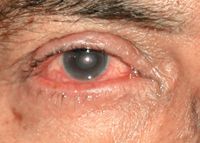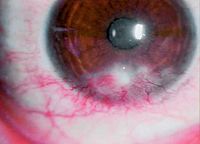Article
Ocular rosacea harder to detect in dark-skinned patients
San Francisco-Ocular rosacea is not a rare disease, but it can be missed easily in individuals with dark skin. Because this can be a sight-threatening disease, ophthalmologists should pay added attention to patients who present with ocular irritation and chronic severe meibomitis, explained Nibaran Gangopadhyay, MS, who described the clinical features and how best to manage the disorder at the annual meeting of the American Society of Cataract and Refractive Surgery.
San Francisco-Ocular rosacea is not a rare disease, but it can be missed easily in individuals with dark skin. Because this can be a sight-threatening disease, ophthalmologists should pay added attention to patients who present with ocular irritation and chronic severe meibomitis, explained Nibaran Gangopadhyay, MS, who described the clinical features and how best to manage the disorder at the annual meeting of the American Society of Cataract and Refractive Surgery.

Dr. Gangopadhyay, director of Eye Care, Techno India, Kolkata, previously worked as a consultant in the department of Cornea in LV Prasad Eye Institute and his colleague Dr. Merle Fernandes from the same institute conducted a retrospective analysis in which patients with grades 1 to 4 acne rosacea were included. Eleven records were excluded because of inadequate documentation, inaccurate data, or acne vulgaris was misdiagnosed as acne rosacea. The investigators evaluated the patient demographic data, clinical history and progression of clinical features, treatment, and the clinical course of the disease.

The mean patient age was 37.2 ± 17.1 years, with a range from 6 to 65 years. The original follow-up was about 6.4 months. Three patients were lost to follow-up.

Ocular symptoms
Most of the patients had more than two symptoms; those appearing most often were redness (63.6%), watering (59.1%), pain (50%), and decreased vision (36.4%). The most common signs were meibomitis (90.8%), corneal scars (59.1%), and blepharitis (50%), with corneal scars being one of the most important causes of loss of visual acuity, according to Dr. Gangopadhyay.
Clinical features of ocular rosacea were found in only 9% of patients before a diagnosis of rosacea was established. Therefore, most disease was diagnosed when patients were examined by Dr. Gangopadhyay and his colleagues. "We diagnosed the disease in 70% of cases at the first presentation, but we missed the diagnosis in nearly a third of the cases," he said.
Even though the diagnosis of acne rosacea is a clinical diagnosis, the investigators could not get confirmation of the diagnosis by a dermatologist in most cases. Only four cases (18.2%) were confirmed. The remaining 13 (59.1%) had grade 3 to 4 acne rosacea, and three (13.6%) had no dermatologic features.
When they evaluated the sites of skin involvement, they found that when the disease progresses, the cheeks, nose, and the forehead-areas of intense sun exposure-are much more involved.
Newsletter
Don’t miss out—get Ophthalmology Times updates on the latest clinical advancements and expert interviews, straight to your inbox.




